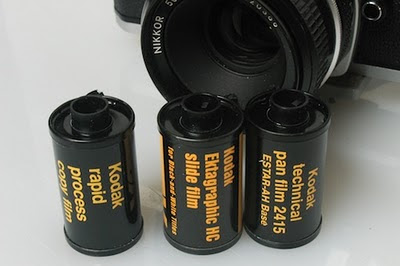
On January 16, I decided to do a little shooting with a couple of odd films that were in my fridge. I have been gradually accumulating a body of work that features winter shots on the Huron River, and I figured that some high-contrast films might lend some different results. Of the three cassettes shown here, the only one that I have any experience with is the TechPan -- an ISO 25 film that when developed in Technidol developer,produces lovely images with full tonality and imperceptible grain. If you develop TechPan in Dektol, you get high-contrast images with no middle tones. So, while it is a very versatile film (alas, no longer manufactured), it is most highly prized for its "grainless" negatives.
This is an example of TechPan used where it does the most good - a long exposure that does not require the use of ND filters.
Fleming Creek on 1/15/2011. Canon A-1, TechPan, 70-210 Vivitar Series 1 lens.
You can see that TechPan renders beautiful tones when developed in Technidol.
The other two films, Kodak Rapid Process Copy Film and Ektagraphic HC Slide Film are totally diferent from each other and from TechPan. Rapid Process Copy Film (RPC) was most likely used for making 35mm copy negatives. It's an extremely slow (ISO is maybe 3 in sunlight) film that one should probably not think of using for pictorial work. The other characteristic is that based on its recommended use, it creates a positive image (which I did not realize until after I removed the processed film from the reel!). The recommended developer is DK-50 (which I have a bunch of) at full strength for 10 minutes.
I bracketed my exposures at 1 sec, 4 sec, 6 sec, and 8 sec at f/16 using my Nikon FM2N and 35-105 Nikkor lens. Here are a couple of resulting images:
Frozen Huron 1
As a copy film, one would expect the RPC to have full tonality, and it does. If you happen to find a roll somewhere, I would start bracketing at 8 sec and go from there. I think be able to have a direct positive is very cool, but of course, this is not a film to be used where objects are moving.
The last film, the Ektagraphic HC Slide Film appears to be nothing more than a variant of Kodalith film, as it was supposed to be used for making high-contrast b&w slides of text (all before Powerpoint obsoleted such uses). The roll I have came from George O'Neal and he has already used part of the roll. I had no idea how much was left -- it turns out I had 6 exposures left, and that was it. I processed the film in Technidol along with a roll of TechPan, and figured with that few exposures, I might learn something. It turns out that the Technidol developer did a pretty good job, though the mid-tones seem somewhat blocked up, and whether that is a film or developer-based result, I do not know. I will experiment with normal Kodalith and Technidol and see what happens.
Herewith is the example:
It's a challenge trying films for atypical uses. You have to decide beforehand, how you are going to shoot the film and that also determines, in the case of high-contrast films -- what developers you can use afterwords. I am very lucky to have access to a lot of photographic literature, and that has been very helpful when trying to figure out what to do with some of these arcane emulsions. Now I need to find some more Rapid Process Copy Film! I have LOTS of DK-50...

3 comments:
Hi Mark
The Rapid process copy was designed to make high quality slides from radiographs. (Could also do a fair job to copy illustrations or line drawings to slide)
The beauty of this film is the speed of processing. Pop it through a Medical X-Omat processing machine for dry, ready to mount film in 90 seconds!
With Xray processing chemistry it produced slides with the same tonal relationships as the original radiograph.
Yes, I had read that about it being used for copying radiographs, and I wish I knew where I picked up that roll. Anyhow, I have a ton of Fine Grain Positive and High-Contrast Copy film to play with!
Thanks,
Mark
I bought 11 unopened rolls of this Kodak RPC135-36 film last week at a flea market, and tried one roll in my 35mm automatic camera, but because there was no way to manually adjust exposure times in my camera, the film did not process correctly?
Not sure what the film is worth but if anyone is interested in the 10 remaining rolls of RPC film, let me know
James
jvl256@yahoo.com
Post a Comment